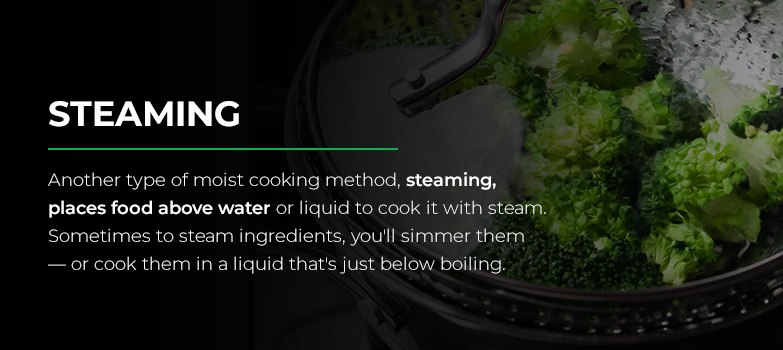Different Types of Cooking Methods Everyone Should Know
Whether you’re starting out in the kitchen or you’re a seasoned pro, you may want to add new types of cooking skills to your culinary repertoire. Learning some simple cooking techniques expands the recipes you can tackle and makes cooking new things a breeze. Use this guide to different types of cooking methods to develop new skills and give your family a taste of something unique.
Cooking Techniques Everyone Should Know
There are many ways of cooking that can enhance your creations in the kitchen. Some cooking methods are better for certain meals, while some ingredients work well with almost any type of cooking. No matter what you learn, you can use your new cooking skills often and in a variety of ways.
Remember that with any cooking method, you want to heat meat and other foods to the correct temperature. For sausage, you want a minimum of 160 F for pork and 165 F for chicken. Check the temperature of sausage and other meats using a meat thermometer for the best results, and be sure to practice kitchen safety when you learn these types of cooking skills.
1. Knife Skills
There’s no heat involved with this cooking technique, but knife skills and cutting methods are essential to know. Have you ever read a recipe that mentioned chopping, dicing and mincing and wondered what the difference is? Here are some common cutting techniques explained:
- Slicing: This method is pretty simple. Cut food into strips lengthwise or widthwise, depending on the item you’re cutting. Most recipes will tell you how thick or thin to slice something, but you can use your judgment or preferences if it doesn’t specify.
- Chopping: Cut something into rough cubes to chop it. The pieces are usually somewhat large based on what you’re cutting, often around an inch. Again, your recipe may specify the general size you’ll want to achieve.
- Dicing: Dicing is a bit more uniform than chopping and creates smaller pieces. You’ll commonly dice onions — and other vegetables you don’t want big pieces of — for a recipe.
- Mincing: This technique creates very small pieces of your ingredients. You’ll often have to mince garlic, onions or celery for a recipe. Chop back and forth across the food until it’s in tiny pieces to mince it.
Remember to use a sharp knife and work on a stable cutting board to avoid any accidents while cutting your ingredients.
2. Sauteing
Sauteing is one of the dry types of cooking with no water involved. Instead, you use a small amount of fat like oil or butter in a pan to cook meat, seafood or vegetables. You only need a bit of fat to coat the bottom of a pan. Any more than that, and you may lapse into frying territory, which immerses food in hot oil to cook it.
When you saute your food, you create beautiful browning that makes your food look and taste good. Many recipes call for sauteing ingredients before adding them to dishes like soups to start the cooking process and develop flavor. You can get creative with this cooking method for delicious toppings. Sauteed strips of peppers and onions on a grilled sausage hero, for instance, make a classic meal.
If you have a variety of ingredients to saute for one recipe, be sure to gauge the cooking time of each ingredient instead of adding them all in at once. Crowding the pan prevents food from browning and may cause it to steam. Adding all the ingredients at once also impacts the cooking time. Some ingredients only need to be sauteed for a few minutes, while others need longer. Remember to keep the pan lid off as you saute, or you’ll end up steaming your food.
3. Braising
If you want a low and slow technique that develops complex flavors over time, go for braising. Braising is one of the moist heat cooking methods, meaning you cook meat or vegetables in a liquid. Use equipment like this for braising:
- A Dutch oven
- An Instant Pot
- A slow cooker
- A large pot
To infuse your meals with flavor, braise food in stock or cooking wine instead of water. Beer is also a popular braising option, especially for brats on the grill. Braising is a perfect technique for tougher cuts of meat as it helps tenderize them. Pair those cuts with hearty root vegetables, like potatoes, to create a braised stew or other comfort meal.
4. Steaming

Another type of moist cooking method, steaming, places food above water or liquid to cook it with steam. Sometimes to steam ingredients, you’ll simmer them — or cook them in a liquid that’s just below boiling. Be sure to cover the pan or pot if you’re simmering and steaming at the same time. Whether you’re cooking with straight steam or a bit of simmering, you can steam ingredients like:
- Vegetables
- Chicken
- Shellfish
- Dumplings or buns
If you have the right tools for the job, steaming is a great way to make boiled quinoa fluffy or cook clams to perfection. You may already have some equipment you can use for steaming, like a small metal colander, a metal sieve or a pot and a lid. You can also get steaming equipment to try this cooking method. Items like electric steamers, steamer pots, steamer racks, bamboo steamers and more are made specifically to boil water underneath food and let the steam rise to cook food gently.
5. Roasting
Crank your oven to 400 F or higher to roast your food. Similar to sauteing, roasting is a dry heat cooking method that helps brown and crisp your food for delicious flavors. Some foods that are delicious when roasted include:
- A whole or split chicken
- Turkey
- Lean cuts of pork, beef or lamb
- Potatoes and other root vegetables
- Pumpkins, squash and similar foods
- Other vegetables like Brussels sprouts
Roasting is a popular cooking technique for fall and winter because it creates warm comfort meals. Try roasting winter veggies and sausage to practice this method and get deep, caramelized flavors that enhance the dish.
When you roast a recipe, you can often use a sheet pan, roasting pan or another oven-safe dish. Leave the dish or pan uncovered for a proper roasting technique. If you cover a dish for the whole cooking period, you may end up steaming your meal instead of roasting it. Instead, try covering for the first part of cooking to keep food moist, then uncover for a roasted exterior. To make food even crispier and more flavorful, brush on a bit of fat. This creates the same effect as oil or butter in sauteing, but on a larger scale.
6. Baking
Lower the heat between 325 F to 375 F to bake your food instead of roasting it. Baking is a more gentle process than roasting, though it can take just as much time, depending on what you’re making.
You can bake just about anything from desserts to casseroles. You’ve probably baked before, whether you made muffins or homemade mac and cheese. Desserts and baked goods don’t typically need to be covered while cooking, but some casseroles and other dishes can be covered to stay moist while baking. Uncover those types of dishes towards the end of cooking to develop a golden color and delicious flavor.
Test Different Types of Cooking Using Premio Sausage
Put these cooking methods to the test with recipes and ingredients from Premio. With Premio sausage, you can be confident you’re getting the best for your cooking with fresh flavors and no fillers. Premio takes recipes to new heights for you and your family.
Check out our products or find Premio at a store near you. Browse our recipes, get cooking and let us know what you learned in the comments!

